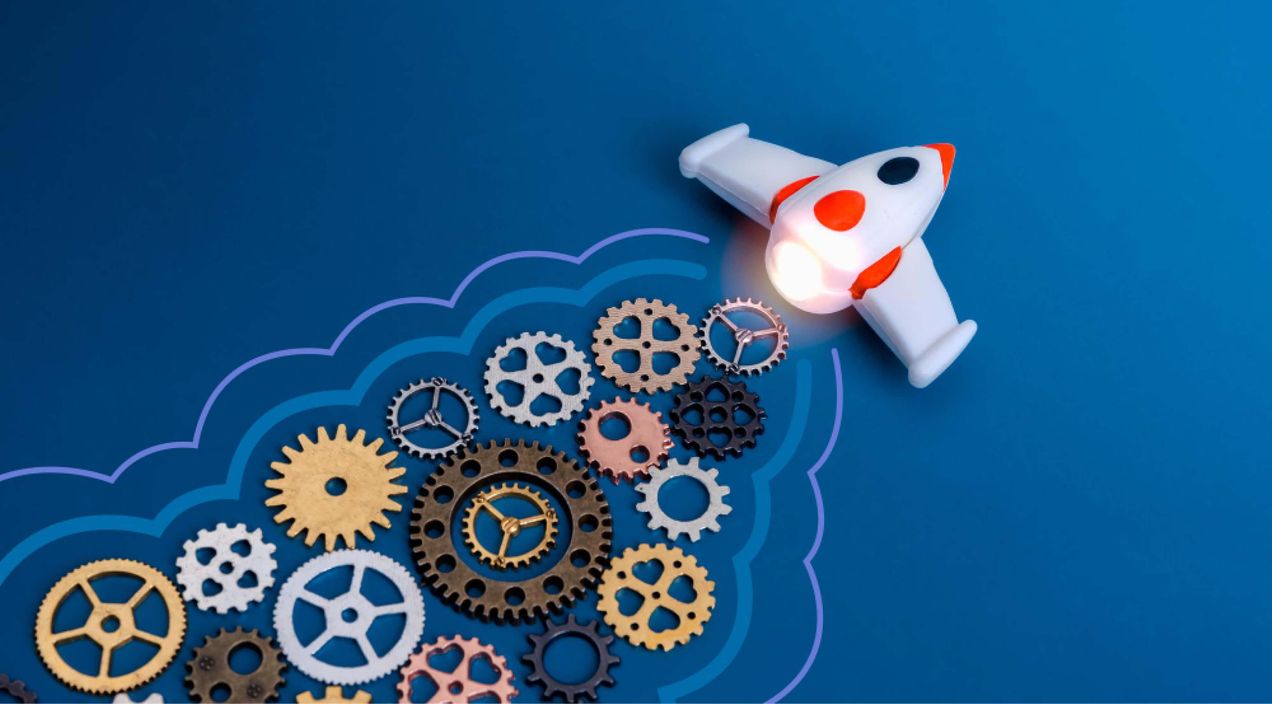Employee growth plan: Top 10 examples that you should try in the workplace

Let’s talk about growth—not just the kind that’s measured on a balance sheet, but the kind that transforms your team from capable to exceptional. An employee growth plan is your secret weapon for building a motivated, loyal, and high-performing workforce.
When your employees see a clear path to advance their careers, they’re not just more productive; they’re more engaged and invested in your company’s success. Think about your team as a garden. Without care and a proper plan, it might survive, but it won't thrive.
An employee development process is like the fertilizer that ensures every plant—er, team member—reaches their full potential. This article will guide you through the top 10 strategies to cultivate your team’s growth, helping you create a workplace where everyone can flourish.
From enhancing skills to fostering a culture of continuous improvement, these employee development initiatives will transform your team’s future. Ready to see your employees blossom? Let’s dig in!
What is an employee growth plan?

An employee growth plan is a structured framework designed to support the professional development and career advancement of employees within an organization.
This plan typically outlines specific business goals, milestones, and timelines for skill enhancement, role progression, and personal development. It serves as a roadmap for both the employee and the employer to ensure alignment with the company’s objectives and the individual's career aspirations.
Employee growth plans are not just about promotions; they encompass a variety of developmental opportunities such as development programs, mentorship, and stretch assignments that challenge employees and help them acquire new competencies.
By clearly defining the steps needed to progress, these plans help employees understand what is expected of them and what they can achieve. They provide managers with a tangible way to support their team’s growth, ensuring that every employee has the tools and resources necessary to reach their full potential.
A well-crafted career development plan benefits both the individual and the organization by fostering a culture of continuous improvement and engagement.
Employee development plan: Goals and benefits

A successful employee development plan is a strategic framework that outlines the development goals and methods for nurturing an employee's professional growth and career trajectory. Implementing an effective employee development plan can significantly enhance both individual and organizational success. Here’s a closer look at its development goals and benefits:
Goals of an employee development plan
- Skill enhancement: The primary goal is to improve the existing skills of employees while introducing them to new competencies that align with their career aspirations and organizational needs.
- Career progression: It aims to create clear pathways for career advancement, helping employees understand the steps they need to take to move up the corporate ladder.
- Performance improvement: By identifying areas of improvement and providing targeted training, these plans help employees enhance their job performance.
- Employee engagement: Development plans aim to increase employee engagement by showing that the organization is invested in their personal and professional growth.
- Leadership development: They focus on identifying and nurturing potential leaders within the organization, ensuring a robust pipeline for future leadership roles.
- Retention: By providing growth opportunities, these plans help in retaining top talent, reducing turnover rates, and maintaining a stable workforce.
Benefits of an employee development plan
- Increased productivity: When employees are equipped with the right skills and knowledge, they are more efficient and productive in their roles.
- Enhanced job satisfaction: Employees who see a clear path for advancement and feel supported in their growth are generally more content with their jobs. Thereby we can equate that effective employee development plans lead to higher employee satisfaction.
- Better performance: Regular training and development lead to continuous improvement in performance, contributing to the overall success of the organization.
- Higher retention rates: Employees are more likely to stay with a company that invests in their development, leading to lower recruitment and training costs.
- Improved morale: Development plans boost employee morale by demonstrating that the organization values their contributions and is committed to their success.
- Talent attraction: A strong focus on employee development can attract high-quality candidates who are looking for growth opportunities, giving the organization a competitive edge in the job market.
- Innovation and adaptability: Employees who are continually learning and developing new skills are better equipped to adapt to changes and drive innovation within the company.
Types of employee development plans

Creating a tailored employee development plan is crucial to boost an organization’s effectiveness by addressing the unique needs of its workforce. There are several types of career development plans, each designed to focus on different aspects of professional growth and skill enhancement. Here are some of the most effective types:
Individual development plans (IDPs)
- Customized learning paths: These plans are tailored to the specific career goals, skills, and interests of an individual employee. They outline a personalized roadmap for skill enhancement and career progression, often including specific training programs, courses, and mentorship opportunities.
- Goal setting and tracking: IDPs help employees set clear, achievable business goals and track their progress over time, ensuring continuous development and alignment with organizational objectives.
Leadership development plans
- Succession planning: These plans are designed to prepare high-potential employees for future leadership roles within the organization. They often include targeted training, leadership coaching, and rotational assignments to expose employees to various aspects of the business.
- Mentorship programs: Pairing emerging leaders with seasoned mentors helps transfer knowledge, build leadership skills, and provide guidance on career advancement.
Skill-based development plans
- Technical skills training: Focused on enhancing specific technical skills required for an employee’s current role or for future career opportunities. This can include certifications, workshops, and hands-on training sessions.
- Soft skills development: Emphasizes the importance of interpersonal skills, communication, teamwork, and emotional intelligence. Programs might include workshops, seminars, and interactive training sessions.
Performance improvement plans (PIPs)
- Targeted interventions: Designed for employees who may be struggling to meet performance expectations. PIPs identify specific areas for improvement, set clear performance goals, and outline the steps necessary to achieve them.
- Support and resources: These plans provide additional support, such as coaching, mentoring, and training, to help employees improve their performance and meet organizational standards.
Career transition plans
- Role transitions: These plans assist employees in transitioning to new roles within the organization, whether through promotions, lateral moves, or career changes. They provide the necessary training and support to ensure a smooth transition.
- Outplacement services: For employees leaving the organization, career transition plans can include services like writing a resume, interview coaching, and job search assistance to support their career move outside the company.
Continuous learning plans
- Lifelong learning culture: Encourages employees to engage in ongoing education and development. This can include access to online learning platforms, tuition reimbursement programs, and professional development workshops.
- Innovation and creativity: These plans focus on fostering a culture of innovation by encouraging employees to pursue new ideas, stay updated with industry trends, and continuously improve their skills.
How do other kinds of development plans fit in?
Other kinds of career development plans fit into the broader framework of employee growth by addressing specific needs and career stages. These plans complement the primary development strategies by providing tailored support, enhancing overall effectiveness, and ensuring that all aspects of employee development are covered.
Onboarding plans
- Smooth integration: Help new employees acclimate to the company culture, processes, and expectations.
- Early support: Provide initial training and resources to ensure a strong start.
Cross-training plans
- Versatility: Equip employees with skills in multiple areas, increasing their flexibility and adaptability.
- Collaboration: Encourage teamwork and understanding across different departments.
Diversity and inclusion plans
- Cultural competence: Train employees on diversity, equity, and inclusion to foster a more inclusive workplace.
- Broad perspectives: Encourage diverse thinking and innovation.
Health and wellness plans
- Well-being focus: Promote physical and mental health through wellness programs and initiatives.
- Work-life balance: Support employees in managing stress and maintaining productivity.
Remote work development plans
- Virtual skills: Enhance employees' ability to work effectively in remote or hybrid environments.
- Technology training: Provide training on digital tools and platforms.
Community involvement plans
- Social responsibility: Encourage employees to participate in community service and volunteer opportunities.
- Networking: Help employees build connections and develop new skills outside the workplace.
The biggest challenges in employee development planning

Employee development planning is crucial for overall business success, but it comes with several significant challenges:
- Identifying individual needs: Employees possess diverse skills and have different career goals, making it tough to develop a universal employee development plan. It requires careful tailoring to align individual aspirations with company objectives.
- Resource allocation: Often, there are limited financial resources available for effective employee development plans and initiatives. Additionally, managing the time employees spend on these activities versus their regular duties can be difficult.
- Measuring effectiveness: Determining the success of development plans is complex. It involves establishing clear metrics and consistently tracking progress, which can be resource-intensive. Gathering and analyzing feedback to make continuous improvements adds another layer of difficulty.
- Managerial support: Gaining and maintaining the active involvement of managers in the development process is essential but challenging. Managers need training to effectively coach and mentor their employees, which requires both time and commitment.
- Employee motivation: Keeping employees engaged and motivated to pursue their development plans over the long term is a persistent challenge. Ensuring that they remain committed to their growth despite daily work pressures is crucial for the success of these plans.
How to create an employee development plan?

Creating an employee development plan involves identifying the skills and career goals of employees, aligning these with organizational objectives, and implementing a structured approach to achieve them. This ensures both employee growth and the fulfillment of company goals.
Here’s a step-by-step guide to creating an effective employee development plan:
- Assess current skills and goals: Start by evaluating the current skills of employees, employees progress and identifying their individual employee development plans. This helps in understanding the gap between where they are now and where they want to be.
- Set clear objectives: Define specific, measurable, achievable, relevant, and time-bound (SMART) goals. These objectives should align with both the employee’s career growth and the company’s strategic goals.
- Develop a tailored plan: Create a customized development plan that includes targeted training programs, workshops, online courses, and other learning opportunities. Ensure the plan is tailored to the individual’s needs and goals.
- Assign resources and support: Provide the necessary resources, such as access to training materials, mentorship, and time for development activities. Ensure managerial support to guide and motivate the employee throughout the process.
- Monitor progress and provide feedback: Regularly review the employee’s progress against the set objectives. Provide constructive feedback and make adjustments to the plan as needed to ensure continuous improvement.
- Evaluate and adjust: At the end of the development period, evaluate the outcomes against the initial goals. Adjust the plan based on what has been achieved and identify new areas for growth to keep the development process ongoing.
10 Examples of employee development plans

A well-rounded approach to crafting a professional development plan involves implementing various plans that cater to different learning styles and career goals. These plans not only support individual growth but also drive the success of the organization. Here are ten effective examples to consider:
- Mentorship programs: Pair employees with experienced mentors who can provide guidance, share knowledge, and offer support. This helps in developing skills, expanding professional networks, and gaining insights into career progression.
- Cross-training opportunities: Encourage employees to learn different roles within the organization. This not only broadens their skill set but also increases flexibility and understanding across departments, enhancing overall efficiency.
- Leadership development programs: Identify high-potential employees and enroll them in leadership training programs. These programs can include workshops, seminars, and rotational assignments to prepare them for future leadership roles.
- Job rotation schemes: Rotate employees through various positions within the company to provide a well-rounded experience. This helps in identifying strengths and interests while fostering a deeper understanding of the organization.
- Continuing education support: Offer financial assistance or time off for employees to pursue further education, such as advanced degrees or professional certifications. This investment in education can lead to higher job satisfaction and loyalty.
- Online learning platforms: Provide access to online courses and e-learning platforms where employees can learn at their own pace. These platforms offer a wide range of subjects, catering to different learning needs and preferences.
- In-house training sessions: Organize regular training sessions on various topics relevant to the organization. These can include technical skills, soft skills, compliance training, and industry-specific knowledge.
- Stretch assignments: Assign challenging projects that go beyond an employee’s current responsibilities. These assignments push employees out of their comfort zones, encouraging them to develop new skills and gain confidence.
- Performance improvement plans: For employees needing development in specific areas, create targeted performance improvement plans. These plans should outline specific goals, provide necessary resources, and include regular progress reviews.
- Wellness programs: Implement programs focused on physical and mental well-being, such as fitness challenges, stress management workshops, and mindfulness training. Healthy employees are more productive, engaged, and likely to stay with the company.
Employee development plan template

To effectively guide employees in their professional growth, it's essential to have a well-structured professional development plan. Here’s a detailed template to assist you in creating these plans:
- Employee information: Include basic details such as the employee’s name, position, department, and manager. This section provides context and helps keep records organized.
- Assessment of current skills: Evaluate the employee’s current skills and competencies. This can be done through self-assessments, manager evaluations, and peer reviews. Identify strengths and areas for improvement to tailor the development plan effectively.
- Career goals: Discuss and document the employee’s short-term and long-term career aspirations. Understanding these goals ensures that the development plan aligns with their personal ambitions and motivates them to stay engaged.
- Development objectives: Set specific, measurable, achievable, relevant, and time-bound (SMART) objectives that the employee should aim to achieve. These objectives should align with both the employee’s career goals and the organization’s strategic needs.
- Action plan: Outline the steps and activities needed to achieve the development objectives. This can include training programs, online courses, workshops, mentorship, job rotations, and stretch assignments. Be specific about the resources required and the timeline for each activity.
- Support and resources: Detail the support systems in place to help the employee succeed. This can include access to learning materials, financial assistance for courses, time allocation for development activities, and regular check-ins with managers or mentors.
- Progress tracking: Establish a method for tracking progress towards the development objectives. This can involve regular meetings with managers to discuss achievements, challenges, and any necessary adjustments to the plan. Use metrics and feedback to measure success.
- Feedback and adjustments: Create a section for ongoing feedback and revisions. Encourage regular feedback from managers, peers, and the employee themselves. Adjust the plan as needed to reflect new goals, changing job responsibilities, or shifts in organizational priorities.
- Review dates: Set specific dates for formal reviews of the development plan. These reviews should assess progress, celebrate achievements, and set new goals for continued growth.
How to follow up after an employee development plan?

Following up after an employee development plan involves regular check-ins, assessing progress, and providing ongoing support. This ensures that employees stay on track and continue to develop their skills and achieve their career goals. Here’s how to effectively follow up:
- Schedule regular check-ins: Arrange periodic meetings to discuss progress, address any challenges, and provide feedback. These check-ins help maintain momentum and ensure that the development plan stays on track.
- Review progress against goals: Evaluate the employee’s progress toward the set objectives. Use metrics and feedback to measure achievements and identify areas needing additional support or adjustment.
- Provide continuous feedback: Offer constructive feedback regularly to guide the employee. Acknowledge successes and provide specific advice on areas for improvement.
- Adjust the plan as needed: Be flexible and ready to make changes to the development plan based on the employee’s progress, new goals, or shifts in organizational priorities. This ensures the plan remains relevant and effective.
- Celebrate milestones: Recognize and celebrate the employee’s achievements as they reach key milestones. This boosts morale and motivation, reinforcing the value of their efforts.
- Encourage ongoing development: Promote a culture of continuous learning by encouraging employees to seek new development opportunities. This could include additional training, new projects, or expanding their responsibilities.
How can HR assist managers in creating an employee development plan?

Human Resources (HR) plays a crucial role in assisting managers to create a effective employee development plan. Here are several ways HR can provide support:
- Providing templates and tools: HR can offer standardized templates and tools that managers can use to create development plans. These resources ensure consistency and completeness across the organization.
- Training and guidance: HR can conduct training sessions for managers on how to create and implement employee development plans. This includes best practices, setting SMART goals, and effectively using feedback.
- Identifying training resources: HR can compile and maintain a list of available training programs, courses, workshops, and other development resources. This helps managers easily find suitable options for their employees.
- Facilitating mentorship programs: HR can help set up mentorship programs by matching employees with mentors who can guide their professional development. This structured support system can significantly enhance the effectiveness of employee development plans.
- Collecting and analyzing data: HR can provide managers with relevant data on employee performance, skills gaps, and career aspirations. This information is vital for creating targeted and personalized development plans.
- Ensuring alignment with organizational goals: HR can ensure that individual development plans align with the broader organizational objectives and strategic goals. This alignment helps in creating cohesive and supportive growth pathways.
- Monitoring progress: HR can assist in setting up systems to track and monitor the progress of development plans. Regular updates and reviews ensure that plans stay on track and adjustments can be made as necessary.
- Offering feedback mechanisms: HR can develop and implement feedback mechanisms that allow employees to share their experiences and provide input on their development plans. This feedback is crucial for continuous improvement.
- Promoting a culture of continuous learning: HR can advocate for a culture that values continuous learning and development. By creating policies and initiatives that encourage ongoing education, HR supports the sustainability of development plans.
Significance of employee development survey in creating their growth plans

Employee development surveys are essential tools for creating effective growth plans. They provide valuable insights into employees' needs, aspirations, and perceptions, ensuring that development efforts are well-targeted and impactful. Here are some key points highlighting their significance:
- Identifying skills gap: Surveys help in pinpointing areas where employees feel they need further development. This allows managers to tailor growth plans to address specific skill deficiencies, enhancing overall competence.
- Understanding career aspirations: By asking employees about their career goals, surveys provide insight into their long-term ambitions. This information is crucial for creating personalized development plans that align with both the employee’s and the organization’s objectives.
- Gauging engagement levels: Development surveys can measure employee engagement and satisfaction with current growth opportunities. Understanding these levels helps managers make necessary adjustments to improve engagement and motivation.
- Collecting feedback on current programs: Surveys can assess the effectiveness of existing development programs. Employee feedback on what works and what doesn’t can guide improvements and the introduction of new initiatives.
- Tailoring training programs: Insights from surveys can help in designing employee development programs programs that are relevant and valuable to employees. Knowing the preferred learning styles and topics of interest ensures that training sessions are engaging and effective.
- Enhancing communication: Conducting surveys demonstrates that the organization values employee input and is committed to their growth. This open line of communication fosters a culture of trust and collaboration.
- Benchmarking progress: Regular surveys allow organizations to track changes in employee development needs and perceptions over time. This helps in measuring the impact of development initiatives and making informed decisions for future plans.
- Supporting strategic planning: Survey data provides a comprehensive overview of the workforce’s development needs. This information is crucial for HR and management when planning strategic initiatives and allocating resources.
Conclusion
Navigating the intricate landscape of employee development can be a game-changer for any organization. We've explored the fundamental components, from crafting personalized growth plans to leveraging insightful surveys and addressing the challenges that come with these initiatives.
Every step, from assessing individual needs to providing ongoing support, plays a crucial role in building a motivated, skilled, and loyal workforce. Imagine your organization as a thriving ecosystem, where every employee is a unique plant requiring specific care and attention.
With the right development plans in place, each one can flourish, contributing to a vibrant, dynamic workplace. Employee development is not just about filling skills gaps or preparing for future roles—it's about fostering a culture of continuous growth, engagement, and innovation.
As you consider implementing or refining your employee development plan, think about the resources and tools that can support you on this journey. By focusing on continuous improvement and valuing employee input, you can create a workplace where everyone feels valued and empowered.
If you're looking for ways to streamline this process, explore how platforms like CultureMonkey can provide the insights and support needed to nurture your team effectively.
FAQs
1. How often should employee development plans be updated?
Employee development plans should be reviewed and updated at least annually. However, quarterly reviews can be more effective in ensuring that organization level goals are aligned with changing business needs and personal career aspirations. Regular updates help in addressing any skill gaps promptly and adapting the plan to any new opportunities or challenges.
2. What role do employees play in their development plans?
Employees should be active participants in their employee development plans. They provide input on their career goals, skills they wish to develop, and feedback on the resources and support they need. Their engagement and commitment are crucial for the success of the employee development plan, making them partners in the process of their growth.
3. Can employee development plans improve retention rates?
Yes, well-implemented employee development plans can significantly improve employee retention rates. When employees see a clear path for growth and feel supported in their professional development, they are more likely to stay with the organization. This sense of progression and personal investment fosters loyalty and reduces employee turnover by a significant level.
4. What types of training should be included in a development plan?
A comprehensive employee development plan should include a mix of technical skills training, soft skills development, leadership training, and industry-specific knowledge. Additionally, opportunities for cross-training, mentorship, and stretch assignments can provide a well-rounded approach to employee growth and must be a part of an employee growth development plan in order to cater to various learning preferences and career goals.
5. How can managers ensure that development plans are effective?
Managers can ensure the effectiveness of employee development plans by setting clear and achievable goals, providing constructive, regular feedback, and offering the necessary resources and support to improve performance. Regular check-ins to monitor progress, celebrating milestones, and being flexible to adjust the plans as needed are also critical. Engaging with HR managers for additional insights and tools can further enhance the plan's success.



